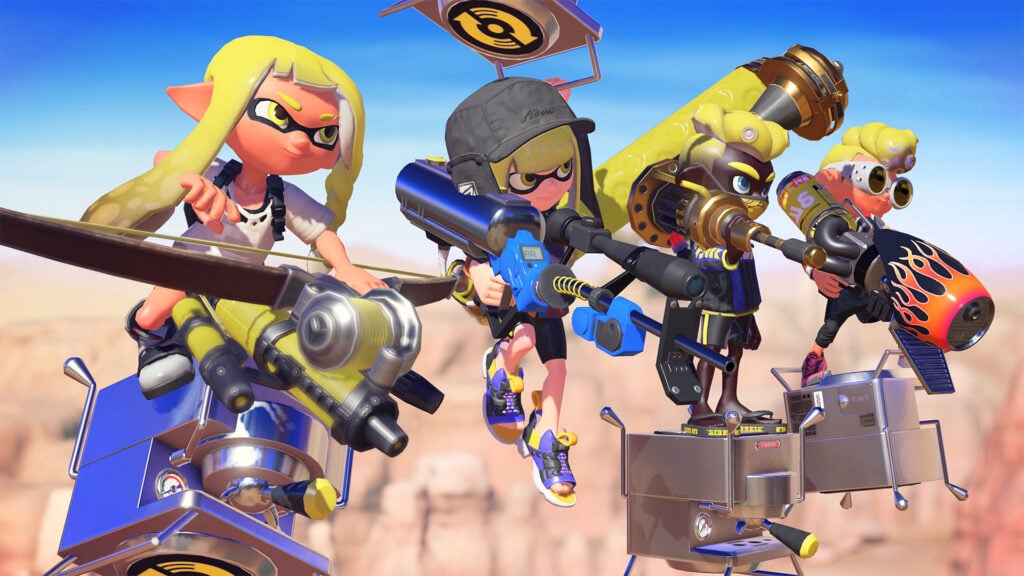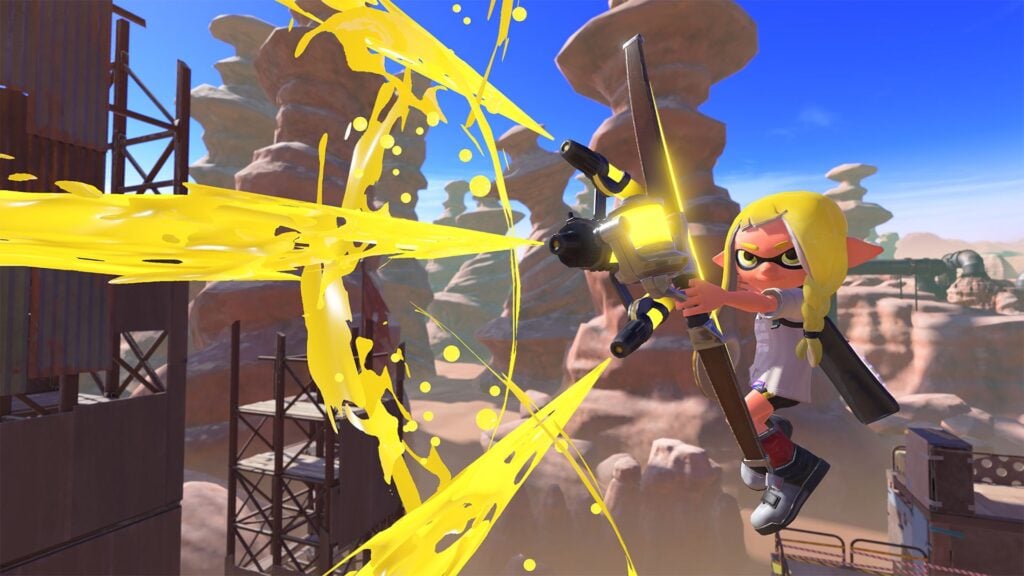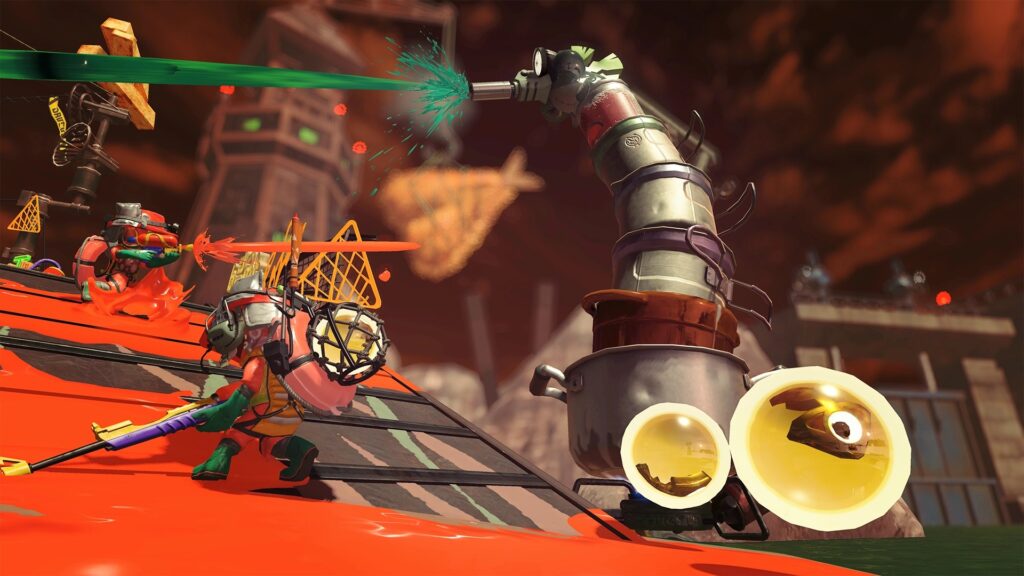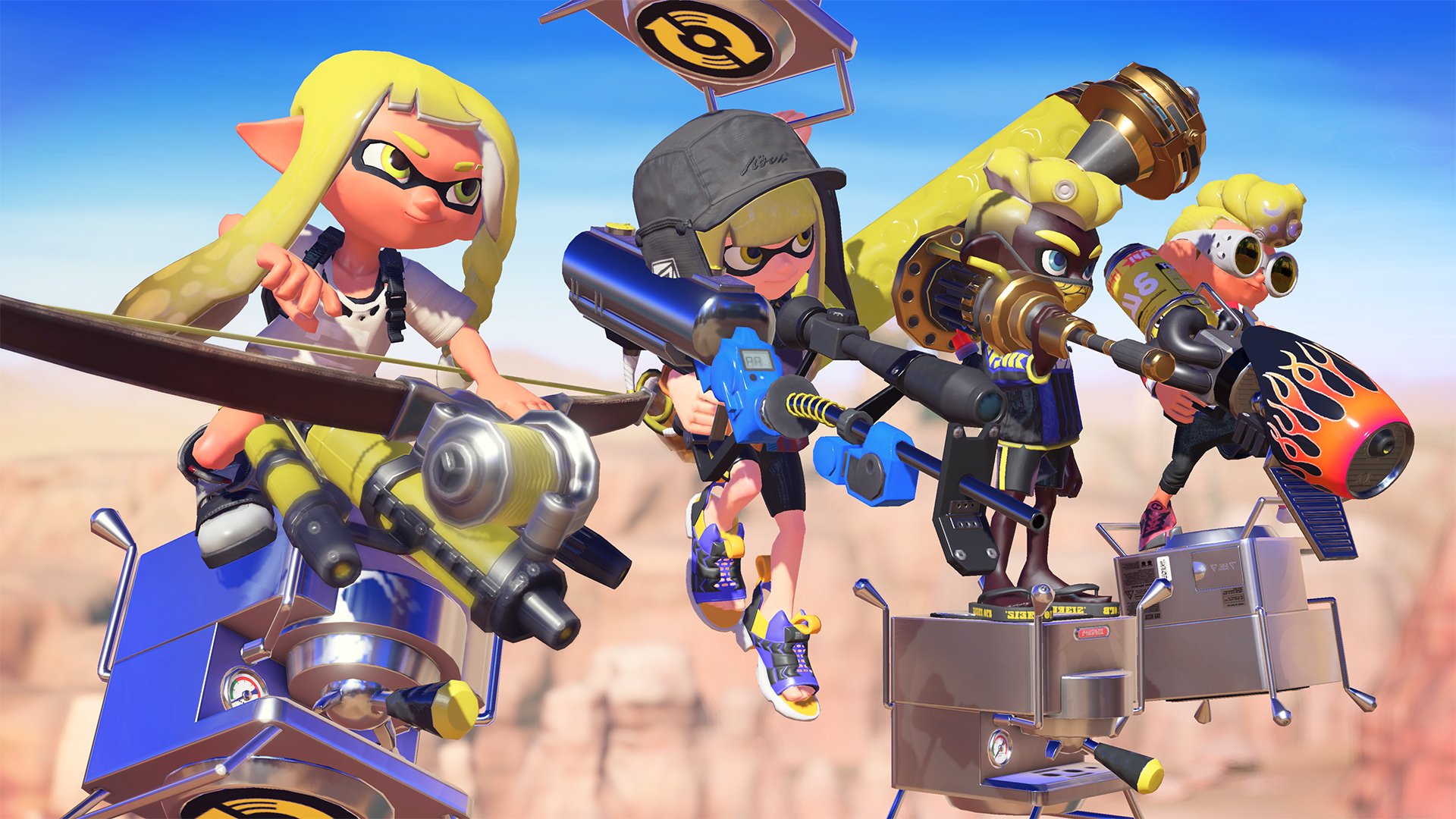Game Reviews
Splatoon 3 Keeps Players on The Hook and Feeling Fresh
Ay, Ay! (Splatoon is back and better than ever!)

Splatoon 3 Review
Developer: Nintendo EPD | Publisher: Nintendo | Genre: Shooter | Platform: Nintendo Switch | Reviewed on: Nintendo Switch
Apparently, it’s a great year to be the third entry in a Nintendo series. After five years since the mega-successful sequel to Splatoon began taking turf on the Nintendo Switch’s modest catalog of shooters and online multiplayer games, the funky fresh post-apocalyptic marine life is back to cover more ground across the world. Splatoon 3 adds more than just another coat of graphical paint to its beloved formula as Inklings and Octolings come together for yet another wonderfully competitive and creative outing of fast-footed ink wars.
Sometimes more of the same is not always a bad thing, as proven by Splatoon 3, which aims to be the pinnacle of the series by refining many of its elements and upping the antics of what players adored most from its predecessor. With a more modernized online experience, quality of life improvements, greater customization, card game puzzle battles, and yet another grand single-player adventure, Splatoon 3 manages to keep the series fresh even if it reserves itself from dangling a new hook in front of players. Like its well-received predecessors, the game has no issues keeping its players submerged in its colorful action level after level alone and match after match online with friends and foes.
Covering All Ground

Right out the gate, when booting up Splatoon 3 after first creating an Inkling or Octoling and playing through the tutorial, the quality of life improvements can already be seen making their way to the surface as players prepare to enter the game’s three main modes. The gameplay of Splatoon 3 may be exactly the same as the other entries in the series, but the execution stacked around the fun precision movement and addictive shooting mechanics is far superior.
For the first time ever, players can now leave the daily broadcast on in the background of the hub world which cuts more than half the time it would normally take to get into any game mode in Splatoon and Splatoon 2. Rather than sitting around quirky menus with upbeat music, Splatoon 3 allows players to practice their skills as they wait for the next match to start up. While the player still cannot switch between weapons or equipment prior to entering the next match, after completing a game they are given time to make their desired adjustments. Visually, as players slowly sink into the gameplay they will notice several icons and indicators have been added to the user interface to help casual and competitive players further keep tabs on all the action.
Whether it’s getting players quickly into online matches, letting them practice with load-outs before inking up the battlefield, or telling the player how and what their teammate was killed by with icons, what Splatoon 3 does best is fix what its predecessors got wrong. Splatoon 3 has evidently been articulated to not tip its scales in favor of a casual approach or a competitive landscape; the game is all in on supporting both sides of a growing fanbase that require their own and shared needs. What was perfect in Splatoon 2 has not been changed, and what needed tweaking has either been completely overhauled or slightly changed to better shape the experience to what all players desire.
When it comes to the overall experience and how game modes specifically operate, Splatoon 3’s developers have shown excellent care for their player base. Once again, Splatoon 3 on the surface is more Splatoon, but those who are most observant and dedicated several hours to the last two entries will pick up on plenty of smart changes–especially those who are all the more competitive.

While the standard Turf War matches have not gone through any major altercations, Ranked Matches have received quite an upgrade in Splatoon 3. The player’s level in Ranked Matches is thankfully no longer dependent on whether or not their team was able to achieve victory. Instead, the newly added medals system doubles down on deciding how players move up and down the global ladder. Even if a player loses a match, they can still make their way up the global leaderboards if they made a recognizable effort. As simple as the medals system is, this is a feature that all ranked shooters should have and take extensive notes on–it seriously works and does the job without making Ranked Match levels unfair or broken.
If there is one aspect of Splatoon 3’s centerpiece that does deserve some criticism, the lack of modes players have until they enter Ranked Matches when they reach level ten still can feel disappointing. While Turf War is Splatoon’s flagship mode, it is a shame that players learning the ropes and making their way up the global leaderboards cannot partake in Rainmaker, Splat Zones, or any of the other Turf War modes early on, as they are all exclusive to Ranked Matches. Perhaps the necessary skill level does help keep these modes from slipping in terms of competitiveness, but that does not mean they deserve to be taken from the hands of new players since getting to level ten can feel like a long albeit rewarding task.
Beyond Turf Wars, Multiplayer Continues to Thrive
Similarly to Turf War’s Ranked Matches, Salmon Run has been heavily refined to solve the silly problems Nintendo had annoyingly created for Splatoon 2’s players. Last time, Salmon Run was inaccessible for the majority of the day as the Grizzco company would only open its doors for employees at select real-life scheduled hours–a neat concept on paper but a design hurdle that should have been patched out with an update shortly after launch. Salmon Run Next Wave thankfully has the conspicuous Mr. Grizz working twenty-four hours a day as players can now head to the salmonoid-infested isles to help clean them up at any time.
Salmon Run Next Wave is still as compelling as Salmon Run, even if the game mode still finds itself under the same gameplay restraints as last time. In contrast to how Turf War targets all players, Salmon Run has always been keen on pleasing a niche audience. Salmon Run Next Wave is, without a doubt, a noteworthy upgrade to its predecessor, but those who previously were not into the mode won’t find any significant new hooks here.
Sticking to three to four-round cooperative missions, Salmon Run Next Wave has added extra bosses to its onslaught of enemies that aim to keep squads from capturing Golden Eggs. Like all of Splatoon’s previous boss battles, the new salmon monsters all have memorable challenges to overcome and eccentric designs that stand out from the single-player’s vast array of enemies. If you loved Salmon Run in Splatoon 2, Next Wave offers players more of what kept them clocking into work, only this time players will have to occasionally work together to combat large sea creatures or small environmental events.
For old and new fans of Salmon Run, the problem with this returning game mode is still the fact that it feels light on content, even in comparison to Tableturf Battles–which we’ll get to in a moment. While the bosses are a blast and the atmosphere of the dilapidated salmonoid-infested zone still excellently captures an ongoing sense of danger, the game mode still feels like something that is yet to fully bloom into a more welcoming experience. What Salmon Run Next Wave could really use is more gameplay options, whether that be unlimited waves to survive or perhaps even specific multiplayer missions varying in difficulty.

Outside of Turf War and Salmon Run Next Wave, Splatoon 3 features one original game mode that noticeably stands on the sidelines in comparison to its three key selling points; the aforementioned Tableturf Battle, a card game that has players taking over turf in a Battleship board game Tetris-like puzzler. Like Turf War matches, Tabbleturf Battle revolves around gaining the most amount of ground–or rather square in this case, to win. By using a deck of cards players can customize and expand by playing Splatoon 3’s other game modes, Tableturf Battle can get shockingly tough and competitive. However, where Tabbleturf Battle falls short is in regards to online play options.
For a sequel that fixes many of its predecessor’s problems, Splatoon 3’s card game suffers from an odd playability setback that none of the other modes face–one that is arguably worse than Salmon Run’s limited hours from Splatoon 2. For some unbeknownst reason, players cannot play Tableturf Battle online with their friends as currently the mode is restricted to local play with multiple Nintendo Switch systems. Perhaps the card game feel makes Tableturf Battle seem like something that should be played in-person only, but the lack of a proper online will inevitably push players away from an admirably comprehensive side addition. With some updates though to add more online elements, surely Splatoon’s newest extra activity could see a boost in recognition from a competitive community of players.
On a side note, why is it that Tableturf Battle is hidden away in Splatsville for players to stumble across? How is there no fast travel to the mode? While online play has been streamlined, the hub world of Splatoon 3 can feel like an enigma in the game’s early hours due to how intricate the layout is. Splatoon hub worlds have always been fantastic due to how easy they were to memorize, but Splatsville takes a major departure from being simple. If it were not for the fast travel menu, navigating Splatsville would be frustrating–especially in comparison to Inkopolis Plaza or Inkopolis Square. Between the usual player-made messages and the level of detail hiding about every local complex, Splatsville is very much a world worth poking around, even if it does not offer much interactivity.
Calamities as Cool as Calamari
Of course, in the face of two irresistible online modes that keep players deep in the action and a competent puzzle mode worth learning to play, the unsung highlight of the Splatoon series has always been the campaign–and the latest entry will not disappoint returning players. Like every other Splatoon campaign, the story mode follows a new agent working with the Squidbeak Splatoon as they jump from level to level around an endangered world in search of the Great Zapfish. The opening may seem as if the campaign is setting up a story following the same beats as its predecessors, but players will quickly be thrown for a loop after the first boss when they meet some familiar faces and fall into a troubled world.

Splatoon 3’s story pulls a lot of inspiration from the Splatoon 2: Octo Expansion DLC as it focuses on level scenarios and characters above all else. In the same vein as the major add-on, this game’s campaign has a mission-based format that asks players to unlock areas via a collectible currency and upgrade a small skill tree of abilities. In terms of gameplay, there is nothing that stands out next to its predecessors, but that does not mean there is not a lot of great content to dig into.
As per usual with Splatoon, many of the levels have quirky layouts that lead to creative puzzle solving, advanced techniques can be used to bypass levels, and the game ends with a mesmerizing set-piece players will surely keep etched into their brains long after their first visit. Meanwhile, the lore of the franchise is constantly being expanded upon as the story opens up a whole can of worms with room for possible DLC scenarios.
What really sells the campaign of Splatoon 3 is the characters. The Splatoon games have always had great dialogue, but the latest entry really does a better job at delivering its corny humor with well-timed moments. There are so many conversations and marine puns to simply smile at to the point where you may just be pulled away from the action to take a moment to read even the smaller pop-ups of text. Those who have played the prior entries and the Octo Expansion will obviously be the ones to get the most storywise out of the new Agent 3’s adventure across the Splatlands, but perhaps Splatoon 3 will also make newcomers want to revisit the game’s predecessor. Even if the drama is not as high stakes as Xenoblade Chronicles or The Legend of Zelda, you can’t help but not want to leave the Splatlands because of how charismatic the whole cast is.
Sadly, in the same troublesome ink as the last two games, and arguably the Octo Expansion, individual-level designs definitely leave a lot to be desired. Every level is still a blast to play, and plenty of missions stick out for their creative usage of the game’s mechanics, but it is a shame that there are no distinguished locations to look back on after completing the campaign. As the player makes their way across Alterna’s site locations, every individual level looks almost exactly the same as one another. Every level has that blocky feel to the point where the backdrops are often the only visual marvel or notable element in the atmosphere. It is a shame that this is still the case, but again, the mechanics are certainly well utilized and provide players with quite a few challenges.
In contrast to the atmospheres of the individual levels, each boss battle in Splatoon 3 is exceptionally memorable and knocks it out of the park when it comes to having their own distinct fights. Without giving away who any of the bosses are, even hours after completing the campaign, it’s easy to visualize how the game’s handful of boss battles played out and the designs of each obstacle. The Splatoon campaigns have always thrived in character designs, but the latest entry blows it out of the water when making their means of offense and defense stand out as well.
Even at its Pinnacle State, The Fish Always Grows

Splatoon 3 shows that Nintendo’s third-person shooter series has come a long way from its Wii U days as it continues to cover the mismatched spots of its beloved 2017 sequel. When directly pit against its predecessor, Splatoon 3 can initially come off as a simple enough upgrade, but only those who indulge in the game’s new content and streamlined changes will realize just how much more is actually being offered under the surface. Splatoon 3 is in every way the pinnacle of the series as Nintendo continues to paint yet another promising future of free content updates and events for players anchoring into the game’s populated online ecosystem after their first match.
Newcomers to Splatoon are getting the best iteration of its gameplay yet with the third entry, and veterans will rejoice with the many wanted refinements. If Splatoon 3 unsurprisingly sounds like just more splatting and jamming to you, it certainly is, and it is well worth the upgrade. With free maps on the way, plenty of upcoming Splatfests to partake in, and more methods of play being promised by Nintendo’s developers, Splatoon 3 has already established a bright future for itself as it will sail on a sea of Switch titles worth playing well beyond launch day.

-

 Technology4 weeks ago
Technology4 weeks agoGamification and Productivity: What Games Can Teach SaaS Tools
-

 Features4 weeks ago
Features4 weeks agoThis Upcoming Romance Anime Might Just Break the Internet; Trailer Just Dropped!
-

 Features3 weeks ago
Features3 weeks agoDon’t Watch These 5 Fantasy Anime… Unless You Want to Be Obsessed
-

 Features2 weeks ago
Features2 weeks ago“Even if it’s used a little, it’s fine”: Demon Slayer Star Shrugs Off AI Threat
-

 Culture2 weeks ago
Culture2 weeks agoMultiplayer Online Gaming Communities Connect Players Across International Borders
-

 Game Reviews3 weeks ago
Game Reviews3 weeks agoHow Overcooked! 2 Made Ruining Friendships Fun
-

 Features3 days ago
Features3 days agoBest Cross-Platform Games for PC, PS5, Xbox, and Switch
-

 Guides3 weeks ago
Guides3 weeks agoMaking Gold in WoW: Smart, Steady, and Enjoyable
-

 Features2 weeks ago
Features2 weeks ago8 Video Games That Gradually Get Harder
-

 Game Reviews3 weeks ago
Game Reviews3 weeks agoHow Persona 5 Royal Critiques the Cult of Success
-

 Features1 week ago
Features1 week agoDon’t Miss This: Tokyo Revengers’ ‘Three Titans’ Arc Is What Fans Have Waited For!
-

 Game Reviews3 days ago
Game Reviews3 days agoFinal Fantasy VII Rebirth Review: A Worthy Successor?




















